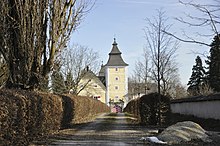Feyregg Castle
The Castle Feyregg located in the municipality Parishes near Bad Hall in District Steyr-Land in Upper Austria (Feyregger Straße 2).
history
The first owner named in 1170 was Otto Sunn, who was still living on a farm called the "fire pit". This belonged to the princely Hofmark Hall. This was followed by his son Heinrich Sunn, who in 1234 called himself Ignis (= fire) in Latin . The last of this family named Walter der Feuer ( Walter dicti fevr ) sold the residence to the Helmhart Annexer in 1378, which was followed by Peter Annexer 1400–1408 from Schloss Köppach . On the way of marriage, Feyregg came to Eberhard Sinzendorfer († 1416) through the follower's daughter Barbara . This was enfeoffed with the seat in 1404 by Duke Leopold IV of Austria . But it wasn't until 1408 that Peter Annexer from Schloss Mühlgrub Feyregg published. After her death, her son Siegfried took over Feyregg from her first marriage. From 1430 only the Feuereck (= Feyregg) seat is mentioned. In 1469 a Christoph Sinzendorfer is mentioned here. His widow Amalie handed over the property to her son Christoph in 1485.
Leonhard Sinzendorfer's daughter Dorothea married Wilhelm Wiellinger von Au in 1560 , who received half of the property; the other went to his brother Balthasar, who was also married to a woman from Sinzendorf. He was succeeded in 1566 by the wealthy Steyr citizen Achaz Fenzl. Hans Fenzl's daughter, also named Dorothea, married Georg Schütter von Klingenberg . Schütter managed his property and so in 1631 the Spital am Pyhrn Abbey bought the property from Feyregg and expanded it into a summer residence for its provosts . From 1717 to 1733 Feyregg was converted into a baroque palace by the master builder Johann Michael Prunner . A well-known plasterer who worked on the castle was Johann Peter Spatz (1652). After the abbey was dissolved, Feyregg came to the Benedictines of St. Blasien. But these were then transferred to Carinthia .
After the abolition of the monastery in 1807, Feyregg was incorporated into the religious fund and sold in 1812 to the Linz wholesaler Franz Planck , whose descendants owned Feyregg until 1905. Then Feyregg came to Karoline von Teuber and her sister Helene Baronin von Ludwigstorff , who were followed by Josef and Karoline von Teuber (1912) and the Harmer family since 1937. Since 1970 the south wing has been converted into a castle pension.
- Feyregg Castle
Feyregg Castle then and now
The castle is located on a hill on the so-called Haselgraben. It is a two- and three-story two-wing building with three towers. The outer tower in the northeastern residential wing does not protrude over the hipped roof with which this part of the castle is covered. The other two towers are much higher. The square tower on the southwest wing of the castle is four-story with a double-broken pyramid roof and a knob at the top. The four-storey tower of the same construction to the north-east forms the connection between the longitudinal and transverse tracts of the hook-shaped building as a stair tower. Today the roof of the farm wing has a crooked roof. The inner courtyard of the palace with a lawn criss-crossed by gravel paths is closed by a high wall. Two gates lead to the former French park and today's nursery. There are coats of arms on both sides of the castle entrance.

The residential wing consists of the old hall of Feyregg Castle and the baroque extension between the hall, old tower and stair tower. This is where the owner's living space is located. On the ground floor are guest rooms, u. a. the so-called presidential room, in which Federal President Karl Renner lived when he was on cure in Bad Hall . On the upper floor there are further living rooms and state rooms with stucco ceilings. One hall has a carved belt ceiling and a multi-flame lead crystal chandelier. In the picture room there is a stove decorated in relief from the middle of the 17th century.
literature
- Herbert Erich Baumert, Georg Grüll : Castles and palaces in Upper Austria, Volume 2: Salzkammergut and Alpine Foreland . Birken-Verlag, Vienna 1983, ISBN 3-85030-042-0 .
- Georg Clam Martinic: Castles and palaces in Austria. Landesverlag in Veritas Verlag, Linz 1991, ISBN 3-85001-679-1 .
- Norbert Grabherr : Castles and palaces in Upper Austria. A guide for castle hikers and friends of home . 3. Edition. Oberösterreichischer Landesverlag, Linz 1976, ISBN 3-85214-157-5 .
- Oskar Hille: Castles and palaces in Upper Austria then and now . Verlag Ferdinand Berger & Sons, Horn 1975, ISBN 3-85028-023-3 .
- Benedikt Pillwein (Ed.): History, geography and statistics of the Archduchy of Austria on the Enns and the Duchy of Salzburg in five parts. Second part . Johann Christ. Quandt, Kastner's soul. Eidam, Linz 1839.
Individual evidence
- ^ Benedikt Pillwein : History, geography and statistics of the Archduchy ... 1839.
Web links
- Entry via Schloss Feyregg to Burgen-Austria
- Feyregg Castle on Burgenkunde.at
- Feyregg Castle on Oberösterreich.at
Coordinates: 48 ° 1 ′ 57.1 ″ N , 14 ° 11 ′ 41.8 ″ E




